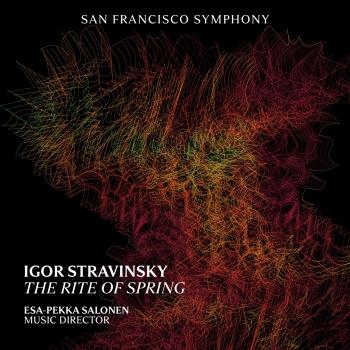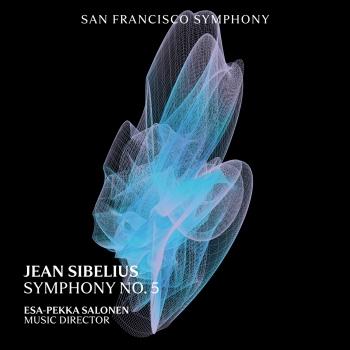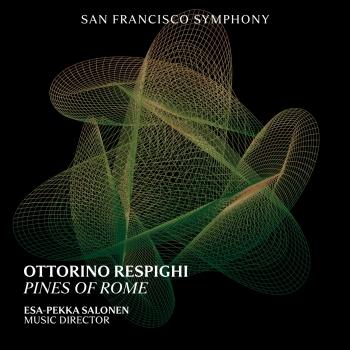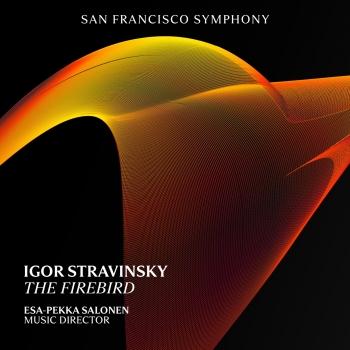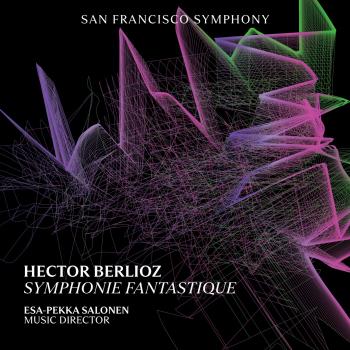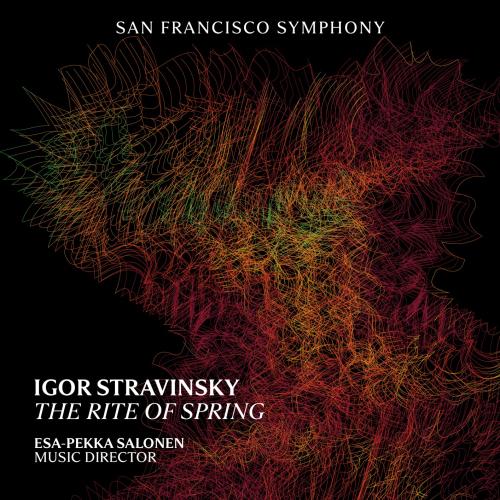
Stravinsky: The Rite of Spring San Francisco Symphony & Esa-Pekka Salonen
Album info
Album-Release:
2023
HRA-Release:
06.10.2023
Label: SFS Media
Genre: Classical
Subgenre: Orchestral
Artist: San Francisco Symphony & Esa-Pekka Salonen
Composer: Igor Stravinsky (1882-1971)
Album including Album cover
I`m sorry!
Dear HIGHRESAUDIO Visitor,
due to territorial constraints and also different releases dates in each country you currently can`t purchase this album. We are updating our release dates twice a week. So, please feel free to check from time-to-time, if the album is available for your country.
We suggest, that you bookmark the album and use our Short List function.
Thank you for your understanding and patience.
Yours sincerely, HIGHRESAUDIO
- Igor Stravinsky (1882 - 1971): The Rite of Spring, Pt. 1 "Adoration of the Earth":
- 1 Stravinsky: The Rite of Spring, Pt. 1 "Adoration of the Earth": I. Introduction 03:27
- 2 Stravinsky: The Rite of Spring, Pt. 1 "Adoration of the Earth": II. Augurs of Spring 03:18
- 3 Stravinsky: The Rite of Spring, Pt. 1 "Adoration of the Earth": III. Ritual of Abduction 01:21
- 4 Stravinsky: The Rite of Spring, Pt. 1 "Adoration of the Earth": IV. Spring Round 04:06
- 5 Stravinsky: The Rite of Spring, Pt. 1 "Adoration of the Earth": V. Ritual of the Rival Tribes 01:48
- 6 Stravinsky: The Rite of Spring, Pt. 1 "Adoration of the Earth": VI. Procession of the Sage 00:41
- 7 Stravinsky: The Rite of Spring, Pt. 1 "Adoration of the Earth": VII. The Sage 00:29
- 8 Stravinsky: The Rite of Spring, Pt. 1 "Adoration of the Earth": VIII. Dance of the Eart 01:16
- The Rite of Spring, Pt. 2 "The Sacrifice":
- 9 Stravinsky: The Rite of Spring, Pt. 2 "The Sacrifice": I. Introduction 04:39
- 10 Stravinsky: The Rite of Spring, Pt. 2 "The Sacrifice": II. Mystic Circles of the Young Girls 03:16
- 11 Stravinsky: The Rite of Spring, Pt. 2 "The Sacrifice": III. Glorification of the Chosen One 01:32
- 12 Stravinsky: The Rite of Spring, Pt. 2 "The Sacrifice": IV. Evocation of the Ancestors 00:42
- 13 Stravinsky: The Rite of Spring, Pt. 2 "The Sacrifice": V. Ritual Action of the Ancestors 03:43
- 14 Stravinsky: The Rite of Spring, Pt. 2 "The Sacrifice": VI. Sacrificial Dance 04:38
Info for Stravinsky: The Rite of Spring
The work was premiered on May 29, 1913 at the Théâtre des Champs-Élysées in Paris, as a staged production of Serge Diaghilev’s Ballets Russes, with Pierre Monteux conducting. Monteux also led the first SFS performances of the original 1913 version in February 1939. Over the years the score has appeared in various revisions. This performance uses the edition marked “Revised 1947; New edition 1967,” brought out by Boosey & Hawkes, which had just acquired the work’s copyright.
Stravinsky’s score has gone down in history as a seminal document of Modernism, bravely forging beyond the already imaginative steps the composer had taken in his works to date. Musicologists have shown that a fair amount of the melodic material in Le Sacre du printemps has at least some connection to actual folk melodies—including the famous, high-pitched bassoon solo that opens the piece, which traces its roots to a Lithuanian folk tune. The fact that so much detective work needed to go into tracing these connections is itself a comment on how completely Stravinsky made these melodies his own. The primal, folk-like spirit of the melodies is translated into a bold musical context marked by polytonal harmonies, unorthodox metric alternations and rhythmic displacements; this constant tension between the simplistic and the complex is a hallmark of the piece. The overriding character of the score resides in proximity to violence. Even the relatively relaxed introductions to the two sections display a measure of nervousness. Where another composer might have used the preludial music to set a bucolic spring-scene against which the proceedings might unroll, Stravinsky said that his opening introduction “should represent the awakening of nature, the scratching, gnawing, wiggling of birds and beasts.”
Thanks to the success of The Firebird, among other works, Stravinsky was somewhat famous before May 29, 1913, but the events of that date—the premiere of Le Sacre du printemps and the accompanying riot by the Paris audience—catapulted him, and modern music, onto a path from which there was no turning back. The Théâtre des Champs-Élysées had opened less than two months before on Avenue Montaigne, a street known, then as now, for its upper-crust, essentially conservative establishments. The theater was appropriately elegant (and remains so), although its decorative appointments were very up-to-date in 1913, enough to alarm a public accustomed to imbibing culture in neo-Baroque surroundings. The theater’s initial bout of programming was far from scurrilous (though the mid-May premiere of Debussy’s Jeux caused anxiety through its suggestions of a ménage à trois), and when the spring season concluded with the “saison russe” of opera and ballet, Diaghilev’s productions alternated with the premiere performances of Gabriel Fauré’s opera Pénélope, on a double-bill with a ballet setting of Debussy’s Nocturnes, both of which tempered their adventurous ideas with an overriding lyricism.
By May 29, the audience was ready to let loose, and it had been primed to do so by advance press reports that not only ensured a sell-out house but also primed the pumps of Parisian cultural gossip. A press release that was reprinted in several Paris newspapers on the day of the premiere tantalized through references to the “stammerings of a semi-savage humanity” and “frenetic human clusters wrenched incessantly by the most astonishing polyrhythm ever to come from the mind of a musician,” promising “a new thrill which will surely raise passionate discussions, but which will leave all true artists with an unforgettable impression.” Cognoscenti already knew how Stravinsky’s score had perplexed the enormous orchestra in the course of its seventeen rehearsals—not counting its rehearsals with the dancers.
The balletic evening opened with Les Sylphides and closed with Weber’s Le Spectre de la rose and Borodin’s Dances from Prince Igor. But what everybody was really there to witness was the second item on the program, and they came ready to participate in accordance with their aesthetic stances; some even had the foresight to arm themselves with whistles. Audible protests apparently accompanied the performance from the opening bars, but things stayed somewhat under control until halfway into the Introduction—which is to say, for about the first minute of the score. Then, to quote Stravinsky, they escalated into “demonstrations, at first isolated, [which] soon became general, provoking counter-demonstrations and very quickly developing into a terrific uproar.” These continued throughout the performance, during which partisans brawled, socialites slapped their neighbors, gentlemen challenged each other to duels, the house lights flashed on and off (Diaghilev’s curious—and ineffectual—attempt to restore order), and Nijinsky stood on a chair just offstage to shout cues to the perplexed dancers. Thus was history made. ...
San Francisco Symphony
Esa-Pekka Salonen, conductor
Esa-Pekka Salonen
is known as both a composer and conductor. He is currently the Music Director of the San Francisco Symphony, where he works alongside eight Collaborative Partners from a variety of disciplines ranging from composers to roboticists. He is Conductor Laureate for London’s Philharmonia Orchestra, where, as Principal Conductor & Artistic Advisor from 2008 until 2021, he spearheaded digital projects such as the award-winning RE-RITE and Universe of Sound installations and the much-hailed app for iPad, The Orchestra; the Los Angeles Philharmonic, where he was Music Director from 1992 until 2009, and was instrumental in opening the Frank Gehry-designed Walt Disney Concert Hall; and the Swedish Radio Symphony Orchestra. He is currently in the midst of Multiverse Esa-Pekka Salonen, a two-season residency as both composer and conductor, at Elbphilharmonie Hamburg; he is also the Composer in Residence at the Berliner Philharmoniker. As a member of the faculty of LA's Colburn School, he develops, leads, and directs the pre-professional Negaunee Conducting Program. He is the cofounder—and until 2018 served as Artistic Director—of the annual Baltic Sea Festival. In 2015 he addressed the Apple Distinguished Educator conference on the uses of technology in music education, and his Violin Concerto was featured in an international campaign for iPad.
This album contains no booklet.









